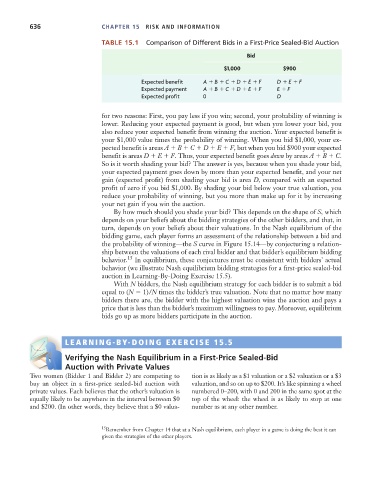Page 662 - Microeconomics, Fourth Edition
P. 662
c15riskandinformation.qxd 8/16/10 11:10 AM Page 636
636 CHAPTER 15 RISK AND INFORMATION
TABLE 15.1 Comparison of Different Bids in a First-Price Sealed-Bid Auction
Bid
$1,000 $900
Expected benefit A B C D E F D E F
Expected payment A B C D E F E F
Expected profit 0 D
for two reasons: First, you pay less if you win; second, your probability of winning is
lower. Reducing your expected payment is good, but when you lower your bid, you
also reduce your expected benefit from winning the auction. Your expected benefit is
your $1,000 value times the probability of winning. When you bid $1,000, your ex-
pected benefit is areas A B C D E F, but when you bid $900 your expected
benefit is areas D E F. Thus, your expected benefit goes down by areas A B C.
So is it worth shading your bid? The answer is yes, because when you shade your bid,
your expected payment goes down by more than your expected benefit, and your net
gain (expected profit) from shading your bid is area D, compared with an expected
profit of zero if you bid $1,000. By shading your bid below your true valuation, you
reduce your probability of winning, but you more than make up for it by increasing
your net gain if you win the auction.
By how much should you shade your bid? This depends on the shape of S, which
depends on your beliefs about the bidding strategies of the other bidders, and that, in
turn, depends on your beliefs about their valuations. In the Nash equilibrium of the
bidding game, each player forms an assessment of the relationship between a bid and
the probability of winning—the S curve in Figure 15.14—by conjecturing a relation-
ship between the valuations of each rival bidder and that bidder’s equilibrium bidding
behavior. 15 In equilibrium, these conjectures must be consistent with bidders’ actual
behavior (we illustrate Nash equilibrium bidding strategies for a first-price sealed-bid
auction in Learning-By-Doing Exercise 15.5).
With N bidders, the Nash equilibrium strategy for each bidder is to submit a bid
equal to (N 1)/N times the bidder’s true valuation. Note that no matter how many
bidders there are, the bidder with the highest valuation wins the auction and pays a
price that is less than the bidder’s maximum willingness to pay. Moreover, equilibrium
bids go up as more bidders participate in the auction.
S LEARNING-BY-DOING EXERCISE 15.5
D
E
Verifying the Nash Equilibrium in a First-Price Sealed-Bid
Auction with Private Values
Two women (Bidder 1 and Bidder 2) are competing to tion is as likely as a $1 valuation or a $2 valuation or a $3
buy an object in a first-price sealed-bid auction with valuation, and so on up to $200. It’s like spinning a wheel
private values. Each believes that the other’s valuation is numbered 0–200, with 0 and 200 in the same spot at the
equally likely to be anywhere in the interval between $0 top of the wheel: the wheel is as likely to stop at one
and $200. (In other words, they believe that a $0 valua- number as at any other number.
15 Remember from Chapter 14 that at a Nash equilibrium, each player in a game is doing the best it can
given the strategies of the other players.

